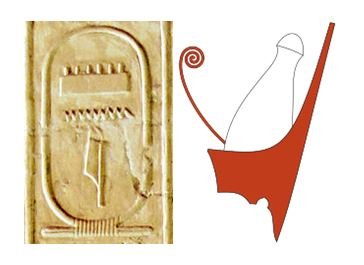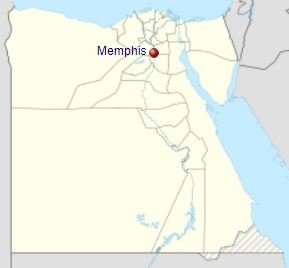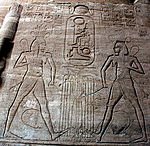Menes – History, Major Facts and Accomplishments

Menes – the Egyptian pharaoh who united the two Egypts | Image: cartouche of King Menes (left) and the two Egyptian crowns that symbolize dominion over Upper and Lower Egypt
Menes was the mighty ruler who according to legend united Upper and Lower Egypt during the Early Dynastic Period of ancient Egypt. Owing to this, he is generally regarded by classical tradition as the founder of ancient Egypt’s First Dynasty (also known as the Memphite Dynasty). He is also credited with establishing Memphis – the first capital of a unified Egypt.
According to Greek historian Manetho, Menes reigned for 62 years and was killed by a wild hippopotamus. However, modern scholars maintain that due to the scanty evidence that exist today Menes perhaps represents all the kings that were involved in bringing Lower and Upper Egypt together. This has led some to identify him with Early Dynastic pharaohs like Narmer and Aha (Hor-Aha).
Quick facts about Menes
Dynasty: 1st Dynasty
Spouse: Neithhotep or Neith-hotep
Religion: Ancient Egyptian Religion
Reign: c. 2930 – c. 2900 BCE
Residence/House: Memphite dynasty
Successor: Hor-Aha (“Horus the fighter”)
Epithets: “He who endures”, “unifier of Egypt”
Other names: Min, Meni, Mena
Most famous for: Unifying Upper and Lower Egypt
Accomplishments: Established Egypt’s first dynasty
Egyptian name: mnj
Greek name: Menes
Association: Aha, Narmer
Meaning of Menes’ name
According to an ancient Egyptian hieratic papyrus (dated to around the reign of 19th Dynasty pharaoh Ramesses II), Menes’ name in Egyptian form is mnj. This form is also similar to the Abydos King Lists – the Abydos Table of seventy-six kings of ancient Egypt. His name mnj is said to translate to “He who withstands” or “He who endures”.
Some scholars have argued that the above epithet used to describe Menes perhaps collectively referred to the Naqada III rulers such as Narmer, Scorpion II and Ka.
The name “Menes” is actually the Greek name the famed Egyptian priest and historian Manetho ascribed to this pharaoh.
Another very popular form of Menes’ name came from the fifth-century BCE Greek historian Herodotus. The historian called the pharaoh Min (Miv). However, some Egyptologists have stated that this form of his name should be discarded, as it refers to Min, the ancient Egyptian god of male fertility.
Read More: List of ancient Egyptian gods and goddesses
Was Menes actually the first king of a unified Egypt?
With the exclusion of an archaeological reference found on ivory label at Nagada, Menes hardly gets any mention in the archaeological records. The name that gets credited with unifying Upper and Lower Egypt is Narmer instead.
Therefore, the verdict is still out there as to whether Menes was indeed the king responsible for the unification.
Famous English historian and Egyptologist Flinders Petrie (Sir William Matthew Flinders Petrie) stated that Menes and Narmer was both one person. According to Petrie, Menes was the royal nebty-name while Narmer is the Horus-name. First Dynasty pharaohs tended to have two royal names – the nebty-name and the Horus-name.

Pschent, the double crown of Egypt symbolizes dominion over Upper and Lower Egypt
Reign and accomplishments
Aside from the Turin Papyrus, much of what we know about Menes came from historians starting around 500 BCE. And much of what was written about Menes bordered on slight exaggeration and legend. According to some sources, the pharaoh was the first human ruler of Egypt, with the previous ruler being the falcon-headed god Horus.
According to some account, he was the inventor of writing, making him receive similar reverence as Thoth, the Egyptian god of wisdom, knowledge and writing.
To put it in simple terms, Menes was revered in a similar manner as the founder of Rome, Romulus, was revered by ancient Romans.
Did you know: The Turin Papyrus manuscript of the 19th dynasty (1292-1190 BCE) provides details about the first kings of Egypt from Menes up to Ramses II, listing the rulers’ names, regnal years, months, and days?
Menes began the Early Dynastic Period
Some Egyptian scholars state that Menes ushered in the Early Dynastic Period, which according to conventional Egyptian chronology lasted between 3050 and 2686 BCE. The Early Dynastic Period was considered contemporary to the early Sumerian Akkadian civilization and other early Mesopotamian cities such as ancient Elam.
According to Manetho, Menes used brute force to accomplish the unification and establish the first centralized administration of the land, resources and people.
Founded the city of Memphis
According to the Turin Papyrus (also known as the Turin Papyrus of Kings) and some works from Greek historian Herodotus, Menes diverted the course of the Nile River in Lower Egypt in order to establish the ancient Egyptian city Memphis. From then onward, Memphis played a key role in Egypt, serving as the capital of ancient Egypt in the Old Kingdom (c. 2686 – c. 2134 B.C.E).
However, Manetho begs to differ, stating that the pharaoh was a native of the province of Thinis. The historian credits the establishment of Memphis to Menes’ son, Athothis.

Map of Lower Egypt showing the important ancient Egyptian city of Memphis
Embarked on several foreign conquests
Upon the political unification of Upper and Lower Egypt, King Menes’s power and resources would certainly have increased, affording him the chance to expand the boundaries of Egypt even further. With his capital at Memphis in Lower Egypt, he most likely deployed a centralized reign, where he had full control over all the labor force and fertile agriculture lands in the Nile Delta.
Took advantage of the profitable trade routes
Egypt’s first pharaoh Menes also benefited tremendously from the various lucrative trade routes to the Levant. Armed with all that resources, Menes, as well as his successors, could afford to put up exquisite royal palaces and fund the various mortuary cults. Under his reign, Egypt thrived and became prosperous.
When did Pharaoh Menes reign?
Due to the lack of any conclusive archaeological findings, many scholars and Egyptologists have come out with different time periods for the reign of Menes. But what is conclusively clear is that scholars place Menes’ reign in the first dynasty. And modern scholars often state that the first dynasty began around 3100 BCE.
Did you know: The dates of the first dynasty have ranged from as early as 5000 BCE to as late 1800 BCE? For example, German Egyptologist Franz Joseph Lauth claimed that the first dynasty began in 4157 BCE.
Succession
According to Flinders Petrie and a number of other scholars, Menes was succeeded to the throne by Hor-Aha.
How did King Menes die?
The pharaoh Menes perhaps represents all the kings that were involved in unifying Lower and Upper Egypt. However, for some scholars and historians, such as Manetho, Menes was a single pharaoh who stayed on the throne for a little bit more than 60 years before he was killed by a wild hippopotamus.
Read More:
Other interesting things worth knowing about Menes
- Another famed ancient Greek historian by the name of Diodorus Siculus credits King Menes with introducing his people to religious sacrifices and the various gods and goddesses. Diodorus also stated that Menes improved the living conditions of his people, injecting a lot of pomp and pageantry into royal affairs and events.
- Some Twenty-Fourth Dynasty Egyptian pharaohs – for example Tefnakht and Plutarch – made disparaging inscriptions about Menes. They called him an opponent of luxury. There is no clear cut reason as to why those pharaohs tried to tarnish his name.
- When Menes was attacked by his own hunting dogs, he is believed to have jumped on the back of a crocodile and rode across Lake Moeris. According to Diodorus Siculus, he founded the city of Crocodilopolis over there.
- A number of scholars claim that the Narmer and Aha monuments found during excavations at Abydos could actually be Menes. To this day, no concrete evidence exists to prove this.
- In 2021, a group of archaeologists led by Deborah Vischak of Princeton University and Matthew Adams of New York University made startling discovery of a 5,000-year-old large-scale brewery at a royal funerary site in North Abydos, 280 miles south of Egypt’s capital Cairo. It’s been stated it well may be the world’s oldest beer factory, according to some scholars of ancient Egypt. The ruins are believed to date to the early First Dynastic Period, under the rule of King Menes (Narmer).
- The unification of Egypt did not happen overnight. It most likely did not occur during the reign of a single pharaoh. Considering the scale of the two lands, the unification process must have been an arduous and bloody endeavor that likely took enormous amount of resources and long periods of time to pull off.

It was believed that the Egyptian god Hapi used the papyrus and reed plants to unite Upper and Lower Egypt


























